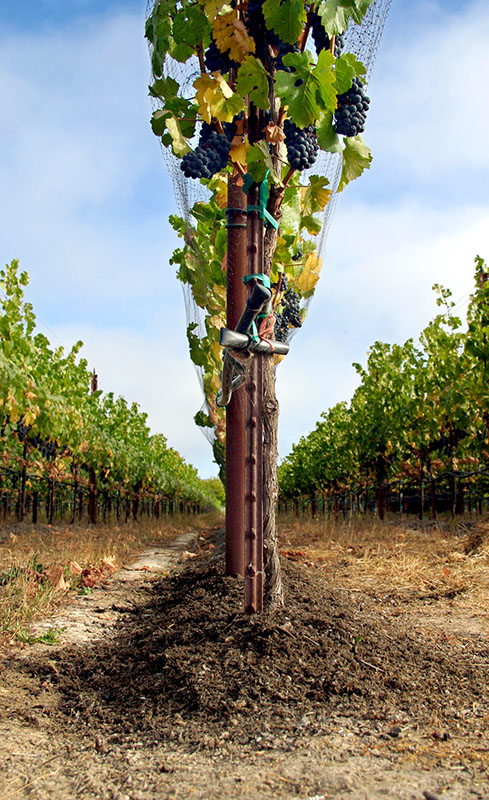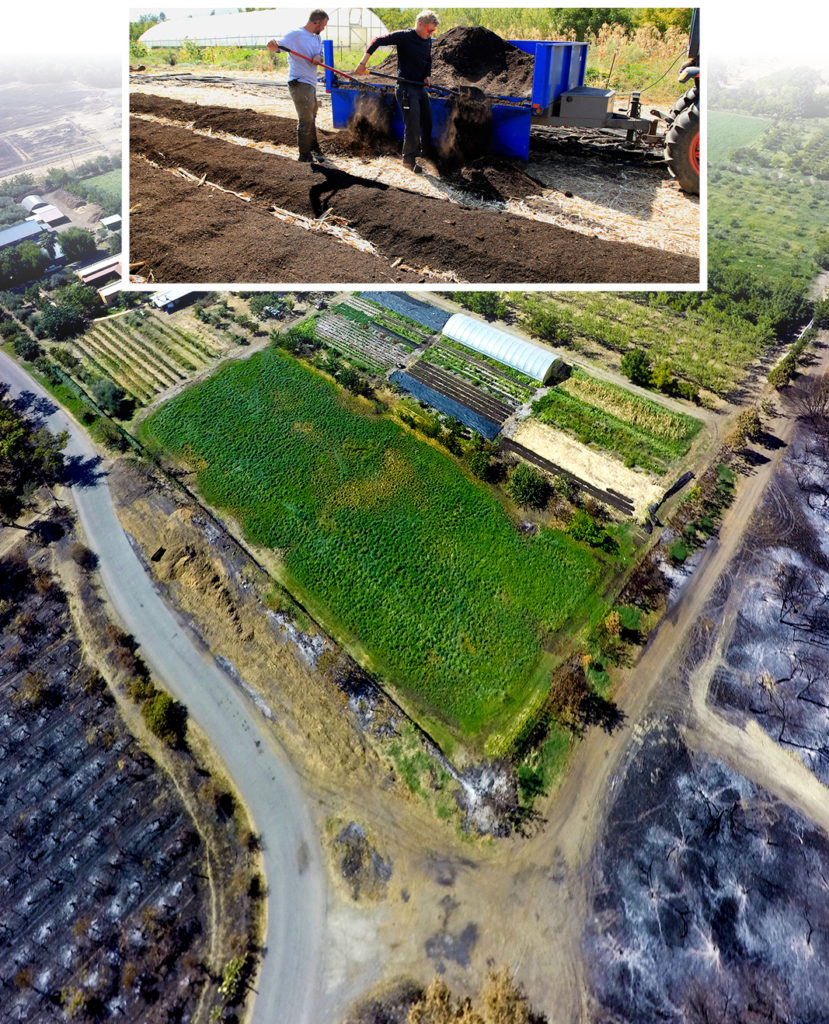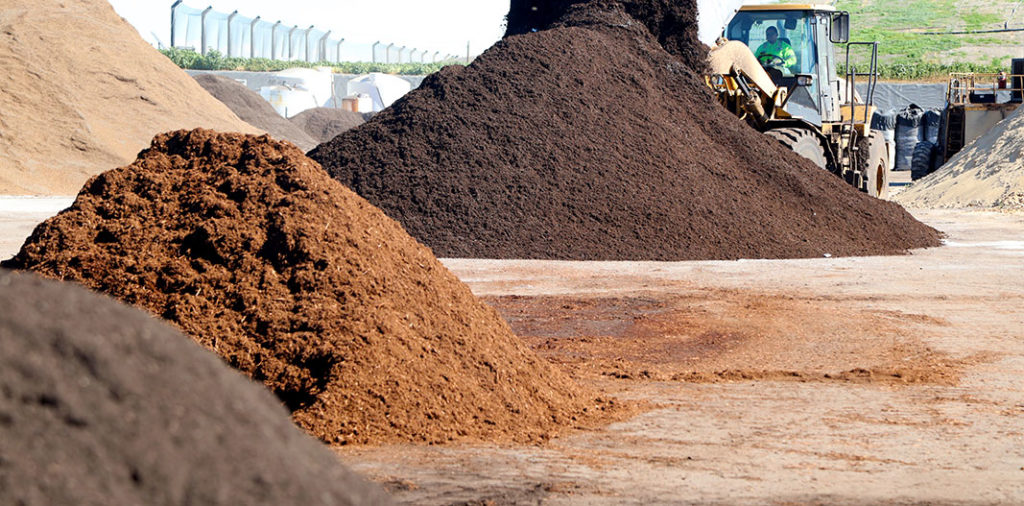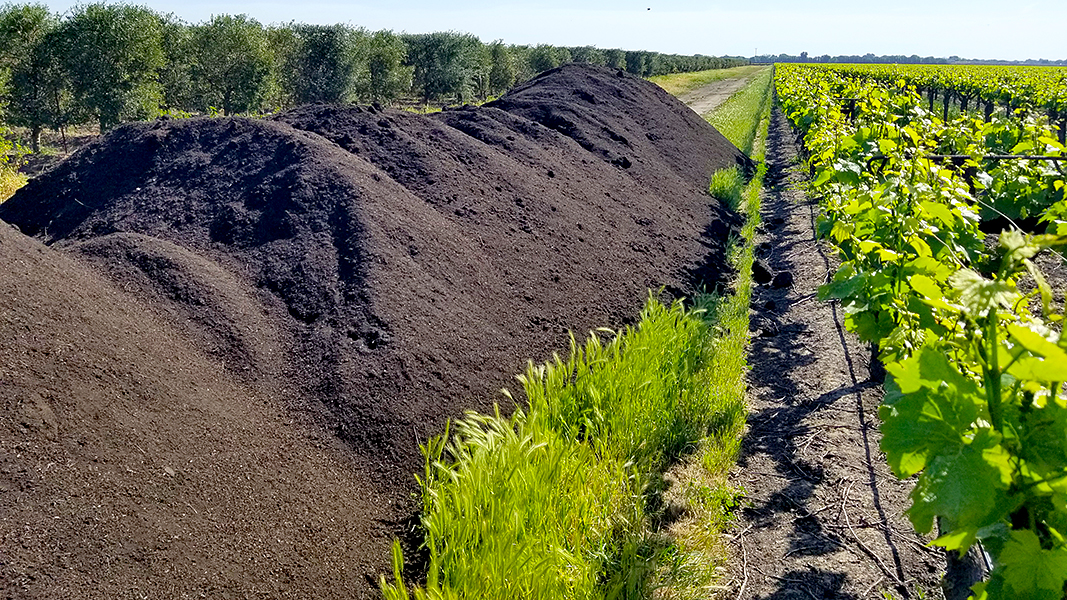Top: Recology compost delivered to 1,600-acre orchard and vineyard in Thornton, California. Photo by Robert Reed, courtesy of Recology
Nora Goldstein

Concentrating compost application over the base of the trees around the roots, combined with drip irrigation, effectively retains moisture in vineyards’ soils. All photos by Larry Strong, courtesy of Recology
In 2017, the Natural Resources Conservation Service (NRCS), housed in the U.S. Department of Agriculture, released an estimate that 1% organic matter in the top 6 inches of soil holds about 27,000 gallons of water/acre. “This estimate is suitable for simple and rough estimates of potential increases in soil water-holding capacities associated with increases in soil organic matter (SOM) where data on the many variables relevant to estimates are not readily available,” notes a CalRecycle fact sheet about use of compost and mulch for water conservation. “For example, it takes 23.5 tons of compost with 50% organic matter (average amount for California compost) to increase soil organic matter by 1% to an average depth of 20 cm [7.9 inches]. Using these assumptions, applying all 3.2 million tons of compost currently produced annually in California increases the amount of water held in soil by about 3.7 billion gallons.”
California is home to 70,000 farms and ranches. Agriculture is a $49 billion industry that employs 800,000 people and generates at least $100 billion in related economic activity per year, according to the California Department of Food and Agriculture. Owners and managers of the state’s farms, vineyards, orchards and ranches are no strangers to drought, which seems to be plaguing California on an ongoing basis. Increasing the pressure is the dwindling supply of water in reservoirs. In August, for example, Lake Mead, the nation’s largest reservoir and a critical water source for California, was at 27%, its lowest level in 85 years.
Adding insult to injury, decades upon decades of conventional agricultural practices have depleted soil organic matter, reducing the available water-holding capacity of the soil. “Organic matter is like a sponge and compost is organic matter,” notes Matthew Engelhart, owner of Be Love Farm, a 21-acre “experiment in regenerative agriculture” near Vacaville, California. “The more of that water-holding sponge you have in the soil, the less water you will need to add.”
Engelhart has been using compost since he and his wife started Be Love Farm 16 years ago. The farm includes a vineyard, orchard and acreage for growing produce. The property is managed for diversity, he explains, with very little ground exposed to the sun. “The more the soil is covered, the less the water in the soil is lost to evaporation,” he says. “The goal is to have water leaving the farm via transpiration — it is how the plant cools itself as it takes water from the soil and transpires through the leaves. For us, it is not just a matter of using compost. It is also keeping green plants on the soil, which yields water conservation and healthy soils.”
He adds that using compost and maintaining green plants on their soil year-round retains moisture near the soil surface, aiding in fire protection. This was put to the ultimate test the night of August 18, 2020 when the Hennessey Fire scorched the Vaca Mountains and rolled down hillsides into Pleasant Valley. The fire destroyed hundreds of structures and burned to the edges of Be Love Farm on three sides. Sparks and embers from the fire ignited wood chips around the base of the trees, but the fire did not take the farm. ““Where plants are green and soil is moist the fire had nothing to feed on,” explains Engelhart.
Sourcing Compost
Be Love Farm purchased compost in the early years from Recology’s Jepsen Prairie source separated organics composting facility near Vacaville. Recology has been managing the City of San Francisco’s residential and commercial organics collection program since 1996, which started as a pilot and then expanded citywide in 2001. “San Francisco’s curbside composting program helped 300 vineyards and orchards through the last big drought from 2011 to 2017,” notes Robert Reed, Recology’s public relations manager. “They used our compost to help keep moisture available to the roots of their crops.”

Compost application at Be Love Farm near Vacaville, CA (inset). The aerial image (above) shows land around Be Love Farm burned by the Hennessey Fire in August 2020.
Initially, compost was spread across the vineyards and orchards at a depth of one-quarter to one-half inch. But as the drought continued, the practice shifted to concentrating the compost around the base of grape vines and orchard trees. This technique helps retain moisture from both precipitation and drip irrigation in the root zone. That precision application of compost has continued into the current drought, which started in 2019.
Recology now brings collected organics from San Francisco and other Bay area cities to its 216-acre composting facility, Blossom Valley Organics North, near Vernalis (CA). The facility receives about 1,200 tons/day of food and green waste. About 95% of the compost produced is sold to orchards, vineyards and other farms. Recology works with agronomists and the growers to optimize the compost and blends it distributes. Soil samples are taken out of the floor of the vineyards and orchards, then analyzed for nutrient and soil organic matter deficiencies. This informs what goes into the custom blends that Recology prepares, e.g., redwood sawdust, rice hulls, gypsum. The same approach is used for crop farming.

The blending pad at Recology Jepson Prairie Organics, near Vacaville, California. Photo by Larry Strong, courtesy of Recology
“Anything we can do to improve the health of the soil is going to improve the water holding capacity,” explains Ed Davis, an agronomist who works with Recology. “We know that when we get the soil right, we can reduce water needs by half an acre-foot in almond orchards, for example.” Almonds are California’s third largest crop and require a lot of water, as do many other crops.
Bob Shaffer, also an agronomist who works with growers in California, Hawaii and internationally, emphasizes the importance of nutrient management when building healthy, productive soils. “Soil testing identifies what a farm, vineyard or orchard needs to apply in addition to compost and use of cover crops to balance their soil’s health,” he says. “The nutrient balance is critical, along with addition of a high-quality form of soil organic matter like mature compost. An example of nutrients in farm soils that have a strong influence on compost’s predictable benefit and on healthy soil-water relations in general are calcium and magnesium in the upper seven inches of soil. If the balance is poor or skewed in the wrong direction, that really changes the dynamics of releasing the water held in the soil.”
The composting process at Recology’s Blossom Valley North facility takes about 60 days, which produces a bacterial-dominated compost that is especially effective for vegetable crops, notes Shaffer. Lately, he has been working more with fungal-dominated composts, which take longer to make, and which have significant capacity to help soils infiltrate water, hold the water captured, and allow the roots to easily access the stored water located mostly on the high surface area of humus (organic matter) and clay (minerals). The key is to match each type of compost to the intended end use and crops to be grown. “Balance is key to consistently growing high quality crops,” he says, referring to the compost volume applied annually, addition of balanced nutrients, and consistent use of cover crops. “It also is important to limit soil tillage as that lowers soil carbon, works against soil health goals and adds to carbon dioxide emissions.”
He recalls working with a farmer in Richvale (CA) who grows rice on a 1,000-acre farm. “Neighbors complained that we must be hiding something from them because we only needed two tillage passes to get the fields ready for planting compared with the typical 12 tillage passes in Stockton Clay with extreme high [cation] exchange capacity,” explains Shaffer. “In reality, it was due to the soil health operating system that includes management of soil organic matter (compost and cover crops), nutrient balance and tillage. Combined, those factors enabled this farm to gain the full range of services provided by an aggregated and well structured 100-year farmed rice soil that only can be created by a large, healthy and diverse population of aerobic beneficial soil bacteria, fungi, nematode and protozoa thriving in a well balanced healthy soil as its food web creates and decomposes carbon.”













